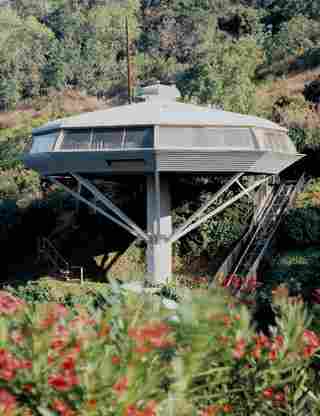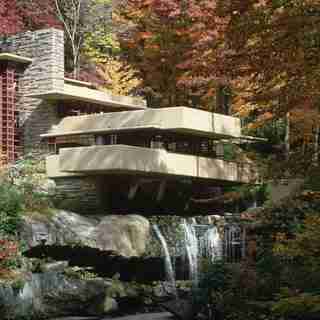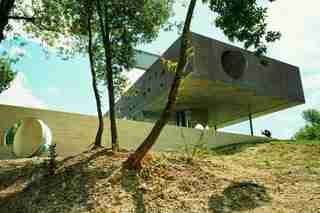
dam-images-architecture-2012-09-innovative-houses-innovative-houses-02-chemosphere.jpg
Chemosphere, Los Angeles
John Lautner
Once proclaimed “the most modern house built in the world,” Chemosphere, completed in 1960 by architect John Lautner (1911–94), still stuns. A sprawling octagonal folly perched atop a stout concrete pylon like a model of a UFO, the structure—reached by way of a vertiginous funicular—is ringed by windows overlooking the urbanized San Fernando Valley on one side and a wild thicket of vegetation on the other. The unorthodox design resulted, in part, from the 45-degree slope of its challenging site. Given the house’s space-age appearance, it comes as little surprise that the original owner, Leonard Malin, was an aerospace engineer. Its voyeuristic spans of glass led it to be used in Brian De Palma’s 1984 movie Body Double and artist Richard Phillips’s 2011 short film Sasha Grey. Chemosphere remains a private home, owned by book publisher Benedikt Taschen, who restored it with Escher GuneWardena Architecture .

dam-images-architecture-2012-09-innovative-houses-innovative-houses-01-fallingwater.jpg
Fallingwater, Mill Run, Pennsylvania
Frank Lloyd Wright
Architect Frank Lloyd Wright (1867–1959) conceived this remote Allegheny Mountain getaway in 1935 for Pittsburgh department-store magnate Edgar J. Kaufmann Sr. and his wife, Liliane. Completed four years later and opened as a museum in 1964, the evocatively named Fallingwater is a dynamic three-story domestic sculpture, composed of intersecting sandstone, glass, and reinforced-concrete planes that spring out of a rock ledge and are graced with great terraces cantilevered over a natural waterfall. Surprisingly, that picturesque cataract is heard rather than seen, a counterintuitive stroke of brilliance that reinforces the impression that Fallingwater is at one with the primeval landscape rather than merely an object from which to view it. The dampness that resulted from the inventive positioning, however, led Kaufmann to wryly call the retreat “Rising Mildew.”

dam-images-architecture-2012-09-innovative-houses-innovative-houses-04-maison-a-bordeaux.jpg
Maison à Bordeaux, Floirac, Gironde, France
Rem Koolhaas/OMA
Equipped with an open hydraulic platform that rises through the core of a complex three-story building, the powerful, provocative Lemoine dwelling—completed in 1998 by architect Rem Koolhaas’s OMA studio—is a startling construction that resulted from a moving précis: to build a home for a family whose father was a paraplegic. Newspaper magnate Jean-François Lemoine (who died in 2001) was adamant that the house commissioned by him and his wife, Hélène, address his disability as discreetly as possible, hence the idiosyncratic platform. Measuring about 11 and a half by ten feet wide, it served as Lemoine’s office, a virtual command center that allowed wheelchair access to each level of the five-bedroom structure while passing along a towering wall that incorporates a library, wine cellar, and art display. The house’s glass-wrapped main level and porthole windows on the third floor offer views of the nearby city of Bordeaux and the Garonne River. A documentary about the home, Koolhaas: HouseLife , was released in 2008 and was directed by Ila Bêka and Louise Lemoine, the eldest daughter of the owner.
dam-images-architecture-2012-09-innovative-houses-innovative-houses-03-gwathmey-residence-studio.jpg
Gwathmey Residence and Studio, Amagansett, New York
Charles Gwathmey
Charles Gwathmey (1938–2009), a founder of the Manhattan-based architecture firm Gwathmey Siegel Kaufman & Associates , made his name in 1965 by crafting an outwardly modest but culturally epochal three-bedroom summer residence for his parents, artists Rosalie and Robert Gwathmey. Joined one year later by a separate but complementary studio, the cedar-clad, 1,200-square-foot house is a graphic composition of basic geometric shapes—rather like a gathering of children’s building blocks—that the architect and his then creative partner, Richard Henderson, protectively wrapped around a glass-fronted core for living. When illuminated at night, the house, now owned by Gwathmey’s widow, Bette-Ann, resembles a Cubist lantern, golden light seeping through discreet glass planes, slits, and perforations.
dam-images-architecture-2012-09-innovative-houses-innovative-houses-06-villa-savoye.jpg
Villa Savoye, Poissy, France
Le Corbusier/Pierre Jeanneret
A sleek white box of reinforced concrete that, thanks to more than a dozen slender columns, seems to levitate above an area for parking, Villa Savoye is an ingenious highlight of the modernist movement in architecture. Now a museum , it was completed in 1930 to the designs of Le Corbusier (1887–1965) and his cousin Pierre Jeanneret (1896–1967), who had been hired by Paris-based insurance executive Pierre Savoye and his wife, Émilie. What they produced was a radical weekend getaway the sophisticated Savoyes dubbed Les Heures Claires, or the Bright Hours, and Le Corbusier called a “box in the air.” The main living spaces are located on the second floor, surrounding a paved courtyard. Horizontal windows animate the minimalist façade like a glittering ribbon, and the flat roof—accessed by the last leg of a gentle ramp that begins at the base of the building—is equipped with a solarium bordered with an undulating windscreen and planting beds.
dam-images-architecture-2012-09-innovative-houses-innovative-houses-07-maison-de-verre.jpg
Maison de Verre, Paris
Pierre Chareau/Bernard Bijvoët/Louis Dalbet
Few houses in the French capital could have been more startling at the dawn of the modernist era than the astounding residence/office complex completed in 1932 for gynecologist Jean Dalsace and his family. Interior designer and cabinetmaker Pierre Chareau, the lead member of a team that included architect Bernard Bijvoet and metalsmith Louis Dalbet, carefully demolished and rebuilt the lower three floors of a four-story, 18th-century townhouse to create an L-shape magnum opus of impressive clinical chic. (The top-floor tenant had refused to move, hence the unusual construction program.) The exterior of the Dalsace commission, only the second of Chareau’s building projects, is largely sheathed in hundreds of textured, translucent-glass blocks, each impressed with a single circle and locked into a grid of dark metal. Encasing the façades like a delicate membrane, the glass filters a filmy, aqueous light through the ingenious interior, its loftlike spaces threaded with five skeletal iron staircases, divided by elegant screens and floored with textured white rubber. Today Maison de Verre is home to architecture enthusiast and collector Robert M. Rubin and his wife, landscape designer Stéphane Samuel; they purchased the property in 2006, restored it, and now offer limited tours. (For an appointment, send an e-mail to mdv31@oranger or call 011-33-1-45-44-91-21.) A documentary about the house by Richard Copans and Stan Neumann can be seen on Vimeo .
dam-images-architecture-2012-09-innovative-houses-innovative-houses-05-the-glass-house.jpg
The Glass House, New Canaan, Connecticut
Philip Johnson
Astonished by the lyrical transparency of Mies van der Rohe’s 1946–51 glass-walled house for nephrologist Edith Farnsworth, the architect Philip Johnson (1906–2005) set to work creating his own transparent domicile. The resulting one-story residence, completed in 1949 and dubbed the Glass House , is an idyll of streamlined clarity—a 56-by-32-foot country house encased by crystalline walls set amid 47 acres of lush woodland. Though the living room and bedroom are in full view from outside, the bath is a sanctum sanctorum, contained within a floor-to-ceiling redbrick cylinder that the architect said was inspired by a memory from the 1930s: the chimneys that remained in a European village after it had been burned to the ground by the German army. Since 2007 the Glass House and many of the eccentric outbuildings Johnson added over the years have been open to the public.
dam-images-architecture-2012-09-innovative-houses-innovative-houses-08-malator.jpg
Malator, Pembrokeshire Coast National Park, Druidston, Pembrokeshire, Wales
Future Systems
Commissioned from British architecture firm Future Systems by politician Bob Marshall-Andrews and his wife, Gill, and completed in 1996, the residence known as Malator is practically invisible, a cunning structure literally subsumed by its national-park site. Responding to strict prohibitions against visible construction, destruction of the landscape, and disruption of wildlife, husband-and-wife architects Jan Kaplický (who died in 2009) and Amanda Levete replaced the old military barrack that had been used as their clients’ vacation getaway with a smaller two-bedroom retreat that is largely underground—a softly contoured, one-story wedge of glass, concrete, timber, and stainless steel tucked beneath an artificial hill. Only a small metal chimney poking through the turf gives away the location of what some observers call the Teletubby house. On the opposite side of the hill, however, concealed from the view of park visitors, a long, crescent-shaped glass wall takes in resplendent rocky views of St. Bride’s Bay and the Atlantic Ocean beyond.
dam-images-architecture-2012-09-innovative-houses-innovative-houses-09-shigeru-ban-residence.jpg
Ban Residence, Lake Yamanaka, Yamanashi, Japan
Shigeru Ban
Cardboard is one of civilization’s humblest materials, but Tokyo-based Shigeru Ban Architects has been transforming it into intimate structures of compelling elegance, from a teahouse to a church to a library to an art gallery. Ban’s paper pavilion of 1995 is a chic riff on his widely admired emergency housing for survivors of that same year’s Kobe earthquake. Designed as his weekend home, it recalls an eco-conscious Barcelona Pavilion, composed of an S-shape coil made of thick vertical logs of recycled cardboard that is inserted into a glass box whose walls slide open to a surrounding terrace. The curves divide the interior into free-form, multifunctional living spaces.
dam-images-architecture-2012-09-innovative-houses-innovative-houses-10-elektra-house.jpg
Elektra House, 84a Ashfield Street, Whitechapel, London
David Adjaye
Elektra House, completed in 2001, helped put British architect David Adjaye of Adjaye Associates on the cultural map. Designed as a home and studio for artists Elizabeth Wright and Giorgio Sadotti, the inexpensive three-bedroom structure is arrestingly moody, its windowless primary façade—a collage of resin-impregnated, timber-composite panels the color of rust—lending a dramatically thuggish presence to a modest neighborhood best known as the haunt of Jack the Ripper. The impassive envelope created by Adjaye, an AD100 honoree, is exceptionally sensitive to its urban context, however. Its scale, for instance, mirrors the surrounding 18th- and 19th-century architecture, the panels correspond in size and placement to neighboring windows, and the ruddy pigmentation echoes the redbrick exterior of a row of townhouses that stands opposite. These decisions ensure that the Wright-Sadotti residence is deferential yet galvanizing. And though the blank appearance of Elektra House seems to eschew contact with the outside world, its interiors are suffused with natural light; skylights illuminate the bedrooms, and the south elevation is made almost entirely of glass.
